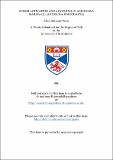Files in this item
Sperm activation and spawning in Arenicola marina (L) (Annelida:Polychaeta)
Item metadata
| dc.contributor.advisor | Bentley, M. G. | |
| dc.contributor.author | Pacey, Allan Anthony | |
| dc.coverage.spatial | 236 p. | en_US |
| dc.date.accessioned | 2018-06-25T15:31:28Z | |
| dc.date.available | 2018-06-25T15:31:28Z | |
| dc.date.issued | 1991 | |
| dc.identifier.uri | https://hdl.handle.net/10023/14562 | |
| dc.description.abstract | The spermatozoa of Arenicola marina are unlike those of most marine invertebrates, in that they become motile in the body cavity prior to spawning. This occurs in response to a Sperm Maturation Factor (SMF) which is released from the prostomium. Prior to activation, spermatozoa are held as morulae with several hundred spermatozoa connected by a common mass of cytoplasm called the cytophore. Sperm activation by SMF is characterised in vitro, in terms of the ultrastructural changes which occur as the sperm become motile, and an active role for the cytophore during sperm activation is suggested. The morphology of these spermatozoa is 'primitive', and ultrastructural observations show that they possess a discoid swelling at the distal end of the flagellum. It is suggested that this may aid in swimming efficiency. The chemical nature of SMF has been putatively identified as 8,11,14-eicosatrienoic acid from both in vitro and in vivo studies. Biochemical investigations demonstrate that sperm activation is linked to an increase in sperm respiration rate, and an elevation of intracellular pH in the order of 0.2 pH units. Levels of ATP in spermatozoa are higher than those reported in other species, and it is considered that quiescence of sperm is not mediated by the deprivation of ATP to the axoneme. It is reported that sperm activated in vitro display a motile life of less than one hour, sperm which has been spawned in vivo, however, can have a motile life of up to 48 hours. It is suggested that this extension in sperm motile life may result from capacitation-like events which occur during activation and release in vivo. A hypothesis for the synthesis of 8,11,14-eicosatrienoic acid, its release from the prostomium, its transportation and mode of action at the level of the spermatozoa is also developed. | en_US |
| dc.language.iso | en | en_US |
| dc.publisher | University of St Andrews | |
| dc.subject.lcc | QL391.A6P2 | en |
| dc.subject.lcsh | Polychaeta | en |
| dc.title | Sperm activation and spawning in Arenicola marina (L) (Annelida:Polychaeta) | en_US |
| dc.type | Thesis | en_US |
| dc.contributor.sponsor | Science and Engineering Research Council (SERC) | en_US |
| dc.type.qualificationlevel | Doctoral | en_US |
| dc.type.qualificationname | PhD Doctor of Philosophy | en_US |
| dc.publisher.institution | The University of St Andrews | en_US |
This item appears in the following Collection(s)
Items in the St Andrews Research Repository are protected by copyright, with all rights reserved, unless otherwise indicated.

